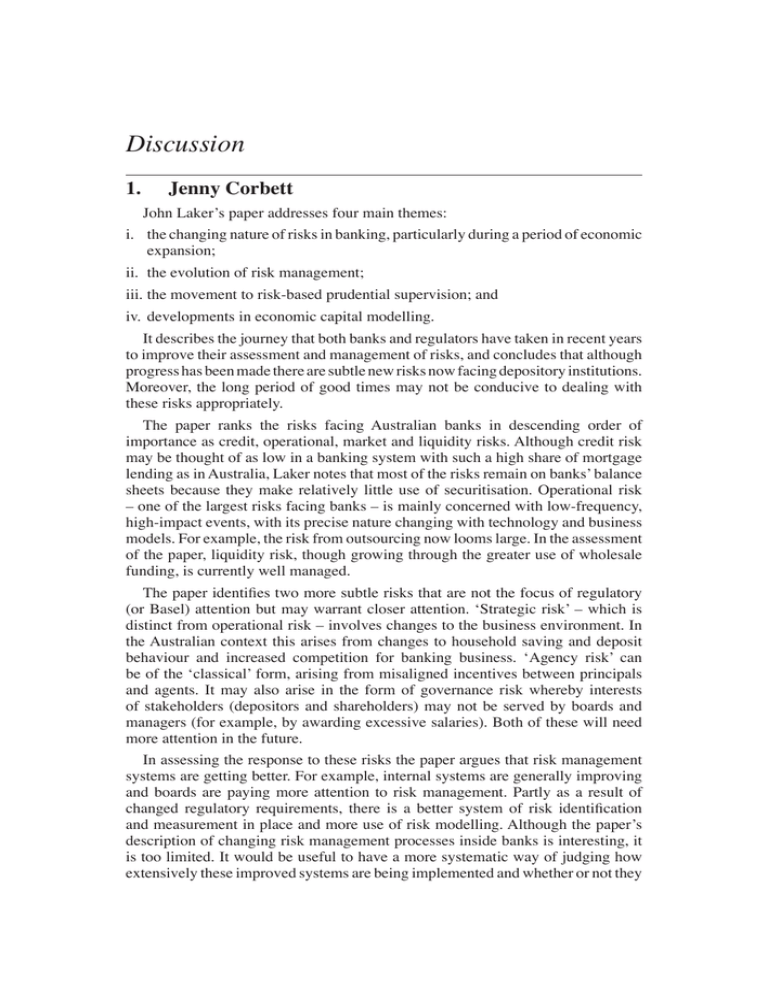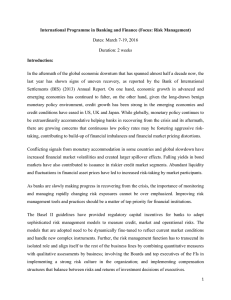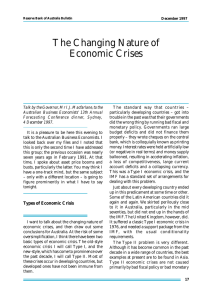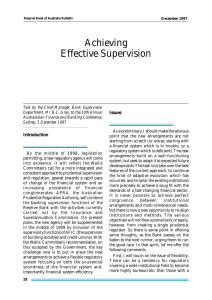Discussion 1. Jenny Corbett
advertisement

318 Discussion Discussion 1. Jenny Corbett John Laker’s paper addresses four main themes: i. the changing nature of risks in banking, particularly during a period of economic expansion; ii. the evolution of risk management; iii. the movement to risk-based prudential supervision; and iv. developments in economic capital modelling. It describes the journey that both banks and regulators have taken in recent years to improve their assessment and management of risks, and concludes that although progress has been made there are subtle new risks now facing depository institutions. Moreover, the long period of good times may not be conducive to dealing with these risks appropriately. The paper ranks the risks facing Australian banks in descending order of importance as credit, operational, market and liquidity risks. Although credit risk may be thought of as low in a banking system with such a high share of mortgage lending as in Australia, Laker notes that most of the risks remain on banks’ balance sheets because they make relatively little use of securitisation. Operational risk – one of the largest risks facing banks – is mainly concerned with low-frequency, high-impact events, with its precise nature changing with technology and business models. For example, the risk from outsourcing now looms large. In the assessment of the paper, liquidity risk, though growing through the greater use of wholesale funding, is currently well managed. The paper identifies two more subtle risks that are not the focus of regulatory (or Basel) attention but may warrant closer attention. ‘Strategic risk’ – which is distinct from operational risk – involves changes to the business environment. In the Australian context this arises from changes to household saving and deposit behaviour and increased competition for banking business. ‘Agency risk’ can be of the ‘classical’ form, arising from misaligned incentives between principals and agents. It may also arise in the form of governance risk whereby interests of stakeholders (depositors and shareholders) may not be served by boards and managers (for example, by awarding excessive salaries). Both of these will need more attention in the future. In assessing the response to these risks the paper argues that risk management systems are getting better. For example, internal systems are generally improving and boards are paying more attention to risk management. Partly as a result of changed regulatory requirements, there is a better system of risk identification and measurement in place and more use of risk modelling. Although the paper’s description of changing risk management processes inside banks is interesting, it is too limited. It would be useful to have a more systematic way of judging how extensively these improved systems are being implemented and whether or not they Discussion 319 make a difference to performance. This is not merely a curiosity but is important in revealing whether we have the means to judge the success of the regulatory philosophy described in the second half of the paper. It should be possible for the Australian Prudential Regulation Authority (APRA) to provide a broad-brush picture of the extent to which depository institutions use various techniques, without breaching confidentiality. If this information were broken down by the size of institutions it would also be possible to assess whether it matters for outcomes. One can imagine a matrix showing different types of institutions and their use of different types of risk management systems. Over time this would provide a view of the improvements in the quality of internal governance. Next I would like to discuss some of the risks that are missing from the list in John’s paper. For example, is the paper too sanguine about risk in the Australian banking system given the sector’s concentration, reliance on mortgages, falling margins and the growing gap between lending and the deposits that have traditionally funded them? These conditions look somewhat like Japan’s banks in the 1990s – and we know what happened there. In Japan there was a decline in high quality corporate borrowers, which led banks to seek alternative higher-risk borrowers. However, because their traditional lending was mainly collateralised by apparently high-quality fixed assets (most often land) Japanese banks had not developed sophisticated credit assessment methods. As the value of the collateral fell, the failure to understand the real quality of the borrowers became critical. The result is history. Can we be sure that our internal governance structures are sufficient to withstand such a squeeze? This is why measurable data on internal structures would be valuable. Another source of concern is the potential for cross-border contagion, given Australian banks’ increasing dependence on wholesale international liabilities. Although this and other papers presented at the conference argue that this risk is mostly hedged, and that the only significant source of cross-border contagion would be New Zealand, the International Monetary Fund has identified it as a vulnerability (IMF 2006). While technology risks are mentioned under operational risk for individual institutions, there may also be a systemic concern about the growth of electronic finance. Not only do new technologies open new avenues for fraud, they also mean that new players can enter conventional markets easily. Although any deposittaking activity immediately brings an institution under the supervision of APRA, the non-regulated sector continues to grow. Since it is hard, even impossible, to anticipate the types of new products and services that may be offered there will certainly be regulatory lag in deciding who should be covered by which regulator. There is considerable scope for research on whether disclosure and reputation effects alone will be sufficient to ensure efficiency and soundness in these sectors. Furthermore, new technology encourages new linkages between the regulated and unregulated sectors and enormously increases the speed with which shocks can be transmitted across the system. All this puts pressure on regulators to be extremely fleet of foot. 320 Discussion The description of risk management included in this paper is not intended to go beyond Australia, yet it does purport to reflect the operation of a ‘best-practice’ system. So, to what extent do these lessons extend to other systems? Most of the papers at the conference use evidence from banking systems of English-speaking economies. While they do not all resemble each other that closely (Australia stands out in many respects), they are more similar to each other than to banking systems in the neighbouring Asian region. There, banks still lend mainly to corporations and although household debt is rising, this is not in the form of mortgages, nor is it securitised to any large extent. If risk-based supervision is to be used in differently structured systems, do the same principles apply? Perhaps the answer is that some do and some do not. Since APRA is in a position to advise and help build capacity in our region it would be interesting for them to reflect on the universality of their ‘principles-based’ approach. The second part of John’s paper describes APRA’s approach to risk-based prudential supervision, now regarded as international best practice. Risk-based supervision may be seen as part of a philosophy that regulation should be ‘principles-based’ rather than rule-driven. It is intended to avoid the straightjacket of one-size-fits-all policy and to allow an approach that is tailored to the circumstances of individual institutions. The term ‘principles-based’ means augmenting Basel capital requirements with, among other things, principles on governance standards, fit and proper criteria for responsible persons, outsourcing and business continuity. One problem with this approach is the regulatory burden it creates. Not only is it labour intensive for the regulator but it creates a significant burden for the regulated entity. The average mutual institution in Australia is likely to require a Board policy document to respond to each of APRA’s policies and guidance documents. This can run to around 40 policy documents with an average length of 20 pages, creating around 800 pages of policy documentation that needs to be reviewed by the Board. While this may not be a major driver of the consolidation trend noted by Kevin Davis, it is a non-trivial issue for small institutions. The paper also outlines APRA’s particular approach to risk-based supervision – the Probability and Impact Rating System (PAIRS) and Supervisory Oversight and Response System (SOARS). For each institution the model calculates the probability of failure based on supervisory judgments, the inherent risks of the business model, management controls and the degree of capital support. This gives the PAIRS rating (an overall risk of failure), which is not disclosed. This probability is then combined with a rating for the impact that such a failure would have in order to place the institution in a SOARS category. There are four categories: normal; oversight; mandated improvement; and restructure. These are disclosed to institutions but are not made public. The paper argues that this system is an effective, best-practice approach but the evidence provided makes it difficult to assess this claim. For example, the paper shows a ‘transition matrix’ of the number of institutions that graduate from a poor state, to either a better state or exit the industry. However, these snapshots do not say anything about whether the regulatory system helps the institutions to improve their status (plausible but hard to prove) nor whether institutions exit more smoothly and with fewer losses than under alternative systems. Discussion 321 The paper also raises the issue of whether the principles-based approach is compatible with Basel II, noting ‘… the very detailed rules associated with the more advanced Basel II approaches … might suggest that a return to a rules-based approach to supervision is unavoidable’. The paper argues that there is no conflict between the two approaches but perhaps the issue merits more discussion. In particular, the old debate about rules versus discretion cannot be regarded as irrelevant, even in the developed markets of Australia, the United Kingdom and the United States and certainly not in developing countries’ financial systems. Does risk-based supervision give too much discretion? This is not mere semantics. During the discussion in other sessions, participants argued that regulatory discretion and forbearance has been a big part of crises. Discussions tried to distinguish between ‘cyclically-adjusted prudential policy’ and ‘discretion which is sensitive to specific circumstances’, with the sense that the former is difficult to achieve while the principles-based approach is trying to capture the latter. This might be regarded as splitting hairs. Recalling the supervisory philosophy of the 1990s, the best practice in the world at the time, prompt corrective action (PCA), was regarded as a panacea because it stopped regulatory forbearance. It established clear rules about the classification of institutions that removed the possibility of collusion between the regulator and regulatee. In Japan, supervisory forbearance was considered so severe that PCA was formally introduced in the late 1990s. The slow and painful transition to rules-based supervision was seen as a triumph of modern views over the vested interests of both supervisors and financial institutions until very recent times indeed. It is not yet clear whether principles-based supervision will be accepted by those who fought against regulatory discretion. Are we so sure that the discretion implied by a principles-based approach will not be a problem for Australia? The IMF had sufficient concerns to raise some relevant issues in its recent Financial System Stability Assessment for Australia (IMF 2006). Another issue that the paper ignores is who should regulate. The paper notes that APRA was an amalgamation of regulators following the advice of the Wallis Commission and faced an early challenge with the collapse of the insurance company HIH. The Wallis Commission had strongly recommended separation of supervisory powers from central banking. While the paper argues that APRA has made good progress in addressing its earlier weaknesses, it does not comment on whether the structure is now optimal, nor how it compares to the alternatives. However, that debate is far from over. In the present circumstances, where liquidity risks threaten the stability of the financial system in many countries, it is clear that there must be close cooperation between regulators and lenders of last resort. If we believe that liquidity provision is likely to be a core task in the new global financial system, there is a stronger case for connecting the two institutions. On the other hand, there is the argument for specialist expertise within a dedicated regulator and the question of conflicts of interest. What if the macroeconomic stance of monetary policy (the responsibility of the central bank) and regulatory requirements conflict? Which is to dominate? Japan’s experience is again relevant here since arguably the anti-inflation stance of the Bank of Japan unduly constrained liquidity provision in the early 1990s. Would 322 Discussion policy have been better if the two functions had been linked? Would the regulatory arm have been able to reassure the monetary policy arm that liquidity provision was necessary but would not prop up failing institutions? If they had, such action would certainly have raised fears about the independence of monetary policy. It also runs the risk that safety nets will be extended inappropriately to other parts of the financial system. If the argument cannot be settled in theory, is there empirical evidence to tell us whether it matters? Čihák and Podpiera (2006) examine a large sample of countries and find that: 33 per cent have a single prudential supervisor; 6 per cent have one agency supervising banks and securities firms; 11 per cent have one supervisor for banks and insurers; 9 per cent have one for securities firms and insurers; while 44 per cent have multiple sector supervisors. The majority of countries still have multiple supervisory agencies but the striking feature of the data is how varied the international experience is. Of those countries with a single regulator, perhaps a third use the central bank for the task. In the Asian region that proportion is generally higher, at least for the supervision of the banks. A key issue though is whether the supervisory structure has an effect on outcomes. Attempts to gauge the effectiveness of integrated supervision are inconclusive (Čihák and Podpiera 2006); income levels and the general quality of the economic regulatory system matter more. In conclusion, this paper gives an informative and detailed picture of what regulated institutions and APRA have done in recent years to better manage risks. It cautions against the complacency that can arise during an extended economic expansion, but is perhaps slightly guilty of not looking harder at where the next risks are coming from and asking questions about whether the regulatory structure is best suited to dealing with them. References Čihák M and R Podpiera (2006), ‘Is One Watchdog Better than Three? International Experience with Integrated Financial Sector Supervision’, IMF Working Paper No WP/06/57. IMF (International Monetary Fund) (2006), ‘Australia: Financial System Stability Assessment’, IMF Country Report No 06/372. 2. General Discussion Stefan Ingves’ proposal for a new pan-European body to supervise the crossborder activities of European banks generated considerable debate. One participant thought that such a body could strengthen the regulatory process but was less certain whether it would adequately take the interests of host countries into account. It was suggested that the same ends could also be achieved via clear and transparent agreements between home and host countries. In response, Stefan argued that such arrangements would be inadequate for meeting the challenges of cross-border banking and they have already become too numerous to manage easily. Another Discussion 323 participant wondered whether Stefan’s proposal was aimed at preventing crises or resolving crises once they had begun. Stefan reiterated that his proposal was aimed at preventing crises. Some also expressed the view that although a pan-European body might be appropriate in the European Union where there is a history of intergovernmental cooperation, it was less clear that an organisation with similar powers would be appropriate in other regions of the world, such as Asia. There was also some discussion of how liquidity crises should be dealt with when they involve institutions with cross-border activities, and the appropriate relationship between central banks and prudential regulators. One participant suggested that if central banks remain separated from regulators, their success in managing crises could be enhanced by holding regular war games. Stefan argued that it is difficult to ring fence liquidity and that central banks are better equipped to deal with such crises than regulators. He also opined that although the optimal relationship between central banks and prudential regulators is unclear, a problem with combining the functions is that central banks tend to have more expertise in monetary policy and may not devote enough time to their prudential responsibilities. John Laker’s paper brought forth a number of questions about prudential regulation in Australia. One participant asked if, because of systemic considerations, APRA put more resources into supervising banks than insurance companies. Another wondered whether APRA had devoted sufficient attention to building up the necessary skills to manage financial crises and whether they conducted regular war games. John responded by saying that APRA does not distinguish between banks and insurance companies per se when allocating resources – although the impact of any given institution on the stability of the financial system was a key factor. He strongly defended APRA’s ability to manage crises, citing the experience gained during the collapse of the insurance company HIH. A number of people expressed reservations about quantitative risk modelling, particularly the way some institutions use it as a profit centre and the difficulty of obtaining accurate confidence intervals for estimates of risk. John Laker acknowledged these concerns, but reinforced that APRA closely monitors what constitutes best-practice risk management and uses this information to make recommendations to any lagging institutions.




